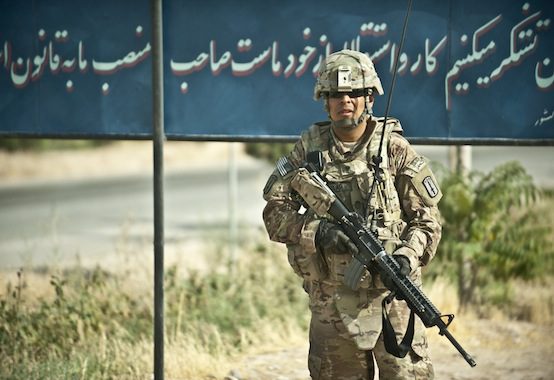Sending More Troops to Afghanistan Won’t Win the War

The Trump administration recently announced that additional troops will be sent to Afghanistan. The move is a mistake and fails to recognize that the foundational problem of the ongoing conflict is political and diplomatic—and will not be solved by the military.
Trump has yet to recognize this reality and is already falling into the same pattern that afflicted previous administrations. In April, the president ordered the largest non-nuclear bomb in the U.S. arsenal to be dropped on a target in Afghanistan. The “mother of all bombs,” is a 30-foot-long, GPS-guided munition that weighs 21,600 pounds.
As impressive as the impact appeared on photographic images, and even though successful on the tactical level, the massive bomb strike will have no strategic effect on the outcome of the war. The last two presidents, covering 16 years of operations, also tried—and failed—to end the war by using progressively more combat power.
Shortly after his inauguration, President Obama expanded the number of troops in Afghanistan by nearly 20,000, and he ordered an additional 30,000 just months later. By the summer of 2011, there were more than 100,000 U.S. combat troops on the ground in Afghanistan. Despite repeated optimistic statements from U.S. military commanders, however, the Taliban and other insurgent groups were not defeated. This outcome was predictable and shouldn’t have taken administration officials by surprise—though many call for the same policies today.
There are three dynamics at play that, if not resolved, make the application of any number of combat troops irrelevant to the equation. First is the problem of sanctuary for Taliban leaders in Pakistan. As has been the case for more than a decade, elements in Pakistan covertly support the Afghan Taliban, resupplying them with replacement fighters, food, clothing, ammunition, and arms.
In his March 2017 testimony before the Senate Armed Services Committee, Central Command’s Gen. Joseph L. Votel reported that “Twenty U.S.-designated terrorist organizations operate in the Afghanistan-Pakistan sub-region,” while emphasizing that “Seven of the 20 organizations are in Pakistan.” Votel concluded that as “long as these groups maintain safe haven inside of Pakistan they will threaten long-term stability in Afghanistan.” Adding more troops to the Afghan side of the equation does absolutely nothing to address this decade-long diplomatic problem.
Second, even if somehow the Pakistan problem could be addressed, there is the challenge of the near-dysfunctional Afghan government. It has remained, in virtually every year since the United States emplaced the interim government in December 2001, one of the most corrupt governments out of 176 ranked. There has been no upward movement in this regard in more than a decade. Sending thousands of additional combat troops will not improve this political corruption.
There is a third problem, however, that might explain why the war continues without resolution after 16 years of futility. When U.S. Forces Afghanistan commander Gen. John Nicholson’s testified to the Senate Armed Services Committee in February, most of the press at the time focused on an exchange between the general and Sen. Lindsey Graham (R-S.C.), which questioned whether 50,000 or 30,000 troops might be needed in Afghanistan. There was an even more important exchange between the two, however, one that suggests how long the conflict may go on:
Sen. Lindsey Graham (to Gen. Nicholson): Can we win?
Gen. John Nicholson: Yes sir.
Graham: Briefly describe what winning would look like.
Nicholson: Number one, the presence of our enduring [counterterrorism] platform protects our homeland—
Graham: So winning for America is to have a footprint in Afghanistan to protect the homeland in the region.
Nicholson: Sir, it would involve the destruction of al-Qaeda in Afghanistan, the destruction of the Islamic State in Afghanistan, helping the government of Afghanistan to expand its control over the population.
Graham: What does losing look like?
Nicholson: Sir, losing would be an attack emanating from this region against our homeland or our allies.
Graham: Is that possible if we leave…is it likely?
Nicholson: Just a matter of time. I think so, sir.
Graham: …The Objective is to win.
Nicholson: That is right.
Graham: The objective is to stop terrorism from growing over there to attack us here at home. The objective is to have the Afghanistan on a trajectory for rule-of-law, democratic nation. Is that correct?
Nicholson: Yes sir.
The senator asked and the general confirmed that in order to win, the U.S. had to “destroy” al-Qaeda, the Islamic State, and have the Afghan government be “on a trajectory” toward a system of rule of law. Even if we do destroy al-Qaeda, ISIS, and any other terrorist groups that arise in the region, the Afghan government is not headed toward effective governance. In other words, this exchange lays the groundwork for the U.S. military to, literally, be made the Armed Forces of the Afghan state forever.
Unless the president convinces the American people that it is a good idea to permanently station troops in Afghanistan to defend the regime in Kabul, and Congress debates the issue and agrees to authorize and fund the mission, Gen. Nicholson’s request for more troops must be denied.
It is time for the administration to develop a new strategy that identifies attainable objectives that safeguard the U.S. homeland. This strategy must neither place an unnecessary burden on the budget nor strain further the Armed Forces. What the president must not do, however, is repeat the mistakes of the past two administrations—by trying to apply yet more combat power to a fundamentally political and diplomatic problem. If President Trump increases the lethal power applied to solve systemic political problems, we’ll see once and for all that there is no path to “victory” in Afghanistan.
Daniel L. Davis is a senior fellow for Defense Priorities and a former officer in the U.S. Army who retired in 2015 after 21 years, including four combat deployments.